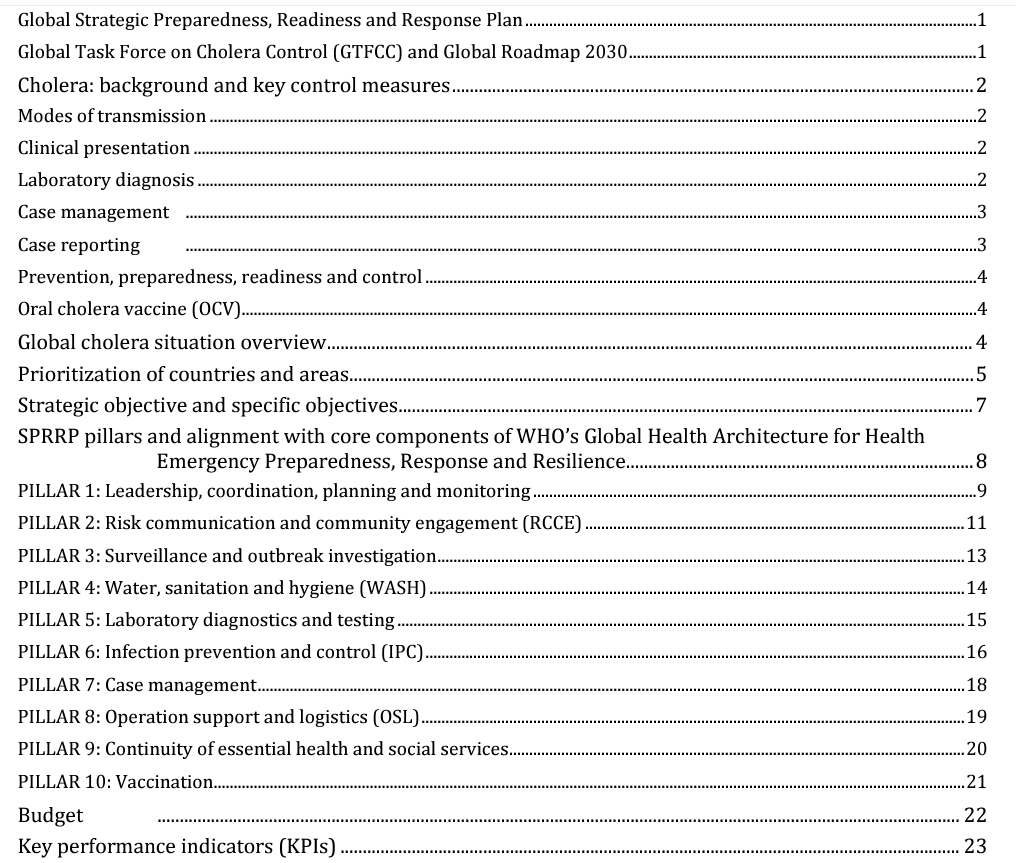chrome-extension://efaidnbmnnnibpcajpcglclefindmkaj/https://cdn.who.int/media/docs/default-source/documents/emergencies/global-cholera-sprrp-v7-2023-05-19_cleared.pdf?sfvrsn=7b5f7ced_1&download=true

Introduction.
Cholera is a major health risk in many parts of the world, affecting millions of people every year. Since mid-2021, the world has been facing an acute upsurge of the seventh cholera pandemic, which is characterized by the number, size and concurrence of multiple outbreaks, the spread to areas that had been free of cholera for decades and alarmingly high mortality rates. The mortality associated with these outbreaks is of particular concern as many countries have reported higher case-fatality ratios (CFR) than in previous years. The average cholera CFR reported globally in 2021 was 1.9% (2.9% in Africa), a significant increase above the acceptable rate (<1%) and the highest recorded in over a decade. Preliminary data suggests similar trend for 2022 and 2023. The progression of several cholera outbreaks, compounded in countries with fragile health systems and facing complex humanitarian crises that are aggravated by climate change poses challenges to outbreak response and risks further spreading of the disease to other countries. The overall capacity to respond to the multiple and simultaneous outbreaks continues to be strained due to the global lack of resources, including the oral cholera vaccine (OCV) and other critical supplies, and overstretched public health and medical personnel, who are dealing with multiple emergencies at the same time. Based on the current situation, including the increasing number of outbreaks and their geographical expansion, as well as a lack of vaccines and other resources, WHO assesses the risk at the global level as very high. Global Strategic Preparedness, Readiness and Response Plan The Global Strategic Preparedness, Readiness and Response Plan (SPRRP) 2023-2024 outlines priorities to prevent, prepare and respond to ongoing cholera outbreaks on a global scale, as well as the resources required by WHO to implement priorities. The SPRRP provides guidance to strategically align preparedness. readiness and response actions across the three levels of the Organization with clear objectives and recommended activities. These activities are intended to cover the period of April 2023 to April 2024 and are focused on immediate emergency preparedness, readiness and response activities. The activities outlined in the SPRRP do not replace existing Global Task Force on Cholera Control (GTFCC) objectives and activities. Global Task Force on Cholera Control (GTFCC) and Global Roadmap 2030 The Global Task Force on Cholera Control (GTFCC), created in 1992 is a partnership of more than 50 institutions, including NGOs, academic institutions, and UN agencies, all working together to end cholera. This network is committed to supporting cholera-affected countries in the global movement to end cholera. It supports the development and implementation of multi-sectoral national cholera plans (NCPs) that are country-focused and country-led. The GTFCC Secretariat sits in WHO, within the cholera programme. It convenes the partners, establishes norms and standards and proposes strategic orientations to the GTFCC Steering Committee. The Country Support Platform is the GTFCC’s operational arm, which was established in 2020 to enhance multisectoral support provided to cholera-affected countries for the implementation of their National Cholera Plans, under the guidance of the Secretariat. In 2017, partners signed onto the Ending Cholera declaration, promising to commit their organization’s resources and to act with urgency to realize a world free from the threat of cholera. That same year, the GTFCC’s new global strategy for cholera control Ending cholera – a global roadmap to 2030 was launched. Focusing on the 47 countries affected by cholera at that time, the strategy targets a 90% reduction in cholera deaths by 2030, and elimination of cholera in 20 countries. 2 The global roadmap focuses on three priority areas. 1. The first is early detection and rapid response, based on intervention such as robust community engagement, strengthening early warning surveillance and laboratory capacities, health systems and supply readiness, and establishing rapid response teams. 2. Second, a targeted multi-sectoral approach to prevent cholera recurrence is called for. The strategy urges countries and partners to focus on cholera “hotspots”, the relatively small areas most heavily affected by cholera. Cholera transmission can be stopped in these areas through measures including improved WASH and use of OCV. 3. The third is an effective mechanism of coordination for technical support, advocacy, resource mobilization, and partnership at local and global levels. Cholera: background and key control measures Modes of transmission Cholera is a diarrheal disease transmitted through the ingestion of contaminated food or water. Although 200 serogroups of V. cholerae exist, only two serogroups, V. cholerae O1 and O139, cause epidemics. The individual infectious dose varies widely and generally ranges from 104 to 108 organisms, depending on host factors. Ingestion can occur directly due to lack of personal or domestic hygiene (mainly hand washing) or through the consumption of water or food contaminated with the faeces of a symptomatic or asymptomatically infected person. Humanitarian crises have often been associated with a higher risk of cholera outbreaks due to disruption of water and sanitation systems, and congregation of large populations displaced into temporary, often overcrowded camps without adequate water and sanitation systems. Clinical presentation Cholera is an extremely virulent disease that can cause severe acute watery diarrhoea (AWD). It takes between 12 hours and 5 days for a person to show symptoms after ingesting contaminated food or water. Cholera affects both children and adults, and severe forms of the disease can kill within hours if untreated. Most people infected with V. cholerae do not develop any symptoms, although the bacteria are present in their faeces for 1 to10 days after infection and are shed back into the environment, potentially infecting other people. Among people who develop symptoms, the majority have mild or moderate symptoms, while a minority (5%) develop AWD with severe dehydration. This can lead to death if left untreated. Laboratory diagnosis Treatment of cholera does not rely on laboratory confirmation of cases. However, timely, accurate, and reliable laboratory results are essential to confirm cholera outbreaks, to discard suspected cases or detect probable cholera outbreaks, and to identify the end of an outbreak. Strategic testing of a representative portion of suspect cases is also needed to monitor incidence of true cholera during outbreaks, to monitor antibiotic susceptibility and to characterize circulating strains. Identification of V. cholerae O1/O139 in stool samples using culture and seroagglutination remains the gold standard for laboratory diagnosis of cholera and monitoring of antimicrobial resistance. Other methods including polymerase chain reaction (PCR) may be used, but confirmation of species, serogroup and, in certain cases, toxigenicity should be upheld. Rapid diagnostic tests (RDT) are used primarily at health care level for surveillance purposes and can greatly speed up detection of probable outbreaks and monitoring of incidence trends of true cholera 3 during ongoing outbreaks. They represent a useful tool for triaging samples to be further tested in laboratories. Antimicrobial susceptibility testing is to be performed regularly to inform management of any changes in strain antibiotic susceptibility profiles. Whole-genome sequencing (WGS), as well as other advanced genotyping methods, can provide additional information including but not limited to establishing a relationship between outbreaks, or tracking the genetic evolution of strains. These methods, however, are of limited value in the context of acute outbreaks. Coordination with field surveillance teams and health facility personnel performing RDTs and sample collection, effective sample referral and transport mechanisms, and availability of quality testing in strategically located laboratories are critical to ensure laboratory functions and ultimately guide response and surveillance activities. Case management The treatment of cholera is focused on rapid rehydration. Cholera patients should be evaluated and treated quickly. Rapid and adequate treatment has been shown to reduce the CFR to below 1%. The majority of people can be treated successfully through prompt administration of oral rehydration solution (ORS). Severely dehydrated patients require the rapid administration of intravenous fluids, preferably Ringer’s lactate solution. Antibiotics can be given in severe cases to diminish the duration of diarrhoea: reduce the volume of rehydration fluids needed and shorten the amount and duration of V. cholerae excretion in stool. Early case detection with well-guided case management will contribute significantly to reduced case fatality and support the prevention of transmission. Community engagement is critical to ensuring that rehydration begins at home as soon as symptoms begin to appear, and that additional care is rapidly sought. Oral rehydration should be available in communities, including at specific Oral Rehydration Points (ORPs), in addition to larger treatment centres that can provide intravenous fluids and 24-hour care. Zinc is an important adjunctive therapy for children under 5. It reduces the duration of diarrhoea and may prevent future episodes of AWD arising from other causes. Breastfeeding should be promoted. Case reporting Under the International Health Regulations 2005 (IHR 2005), notification of all cases of cholera is not mandatory. However, public health events involving cholera must always be assessed against the criteria provided in the regulations to determine whether there is a need for official notification. Daily reporting is required where cholera is confirmed. In a surveillance unit (for example a district, or province) where there is no ongoing confirmed cholera outbreak, any person infected with V. cholerae O1 or O139 identified by presumptive identification (culture/seroagglutination) or PCR is considered a confirmed case. The strain should also be tested for toxigenicity (by PCR) if there is no concomitant confirmed cholera outbreak in other surveillance unit(s) of the country and if there is no established epidemiological link to a confirmed cholera case/ source of exposure in another country. Reports should include the number of new cases and deaths since the previous report and the cumulative totals for the current year or since start of the outbreak, if the outbreak continues across several years. If available, information on the location of the cases should be provided at the first and second administrative units, at minimum. Whatever the source of the information, when suspected cholera cases are detected or reported in a previously unaffected area, a cholera alert should be triggered, and immediate field investigation should be conducted to verify the alert and confirm the outbreak. Once the presence of cholera in an area has been confirmed, it is not necessary to confirm all subsequent suspected cases. 4 Prevention, preparedness, readiness and control Prevention and preparedness for cholera require a coordinated multidisciplinary approach. Measures for the prevention of cholera mainly consist of providing proper access to sanitation and safe water to populations who do not have access to essential services. Communities should be engaged in the planning and implementation of all aspects of readiness and response for cholera outbreaks to support the creation of an enabling environment for the adoption of protective and preventative behaviours. These include hand hygiene (especially after contact with faeces), food safety, using safe water for cooking and drinking, getting vaccinated (if available), rapid rehydration and care seeking for cholera cases, and careful management of dead bodies. In addition, strengthening surveillance and early warning are key to more rapidly detect the first cases and to put adequate control measures in place. Once an outbreak is detected, the usual intervention strategy aims to reduce the CFR below 1% by ensuring access to treatment and controlling the spread of disease. The main control methods are: • early detection and confirmation of cases; • effective, timely and safe case management in CTC/CTU/ORP, facilitated by specific training for proper case management, including implementation of appropriate IPC measures; • sufficient pre-positioned supplies for case management, including IPC supplies; • improved access to safe drinking-water, safe excreta disposal and proper waste management; • enhanced hygiene and food safety practices, such as safe food handling, preparation and storage; • customized context specific RCCE and public information for behaviour change. Oral cholera vaccine (OCV) The oral cholera vaccine (OCV) should be used in selected cholera hotspots and during cholera outbreaks. OCV should always be used in conjunction with other cholera prevention and control strategies (such as case management and emergency WASH). Since 2013, the International Coordinating Group (ICG) has managed the global stockpile of OCV which was created as an additional tool to help control cholera epidemics. The ICG is an international group that manages and coordinates the provision of emergency vaccine supplies and antibiotics to countries during major disease outbreaks. The group is composed of members of WHO, Médecins Sans Frontières, UNICEF and the IFRC. Since the establishment of the cholera vaccine stockpile in 2013, 140 million doses of OCV have been shipped to 26 countries, of which 94 million (66%) have been approved for use in emergency responses. Since January 2022, nearly 39 million vaccine doses have been shipped to 15 countries. The global surge in cholera cases has put a strain on the ICG OCV stockpile, and dose supply is not sufficient to meet demand. The strained global supply of cholera vaccines obliged the ICG to make the decision in October 2022 to temporarily suspend the standard two-dose vaccination regimen in cholera outbreak response campaigns, using instead a single-dose approach, and to cease preventative campaigns in at risk cholera hotspots. Global cholera situation overview As of 10 May 2023, 24 countries were reporting cases of cholera. Since the beginning of 2023, outbreaks have spread further in south-east Africa. The widespread and extended outbreaks in Malawi and Mozambique remain active, although weekly reported cases and deaths have continued to decrease in the past weeks. Additional outbreaks have been reported in Eswatini, South Africa, the United Republic of Tanzania, Zambia and Zimbabwe since the start of 2023. 5 In the Greater Horn of Africa, the epidemiological situations in Ethiopia, Kenya and Somalia remain a growing concern with increasing number of reported cases and further spreads to new areas. The outbreak is especially concentrated in the region where borders of all three affected countries meet and population movement across borders drives transmission between countries. For the latest situation overview, consult the monthly WHO Global Cholera Situation Report here. Prioritization of countries and areas The SPRRP has been developed and structured in accordance with country risk level, attributed by the repeated and dynamic prioritization process described below. The prioritization is evidence-based and will help decisions to allocate support based on repeated dynamic risk evaluation which relies on epidemiology, context and capacity to respond. Therefore, cholera affected, and at-risk countries, areas and communities are grouped into three categories: acute crisis, active outbreak, preparedness/readiness. Epidemiological indicators include the historical trends of cholera in a given country or area. The size of the current outbreak is based on the number of reported cases; geographical spread; the severity based on the CFR; and trends of all epidemiological indicators listed. Response indicators include the availability of functional CTCs/CTUs/OPRs and the local capacity to contain, control and stop transmission of cholera. Contextual indicators consider seasonality, access to safe water sources, and risk factors such as conflict, the presence of internally displaced people, bordering an ongoing cholera outbreak and natural catastrophes. Fig. 1 below shows the map of prioritization of countries and areas as of 10 May 2023, which is detailed in Table 1. Acute crisis Acute crisis status corresponds to a situation where an epidemic is rapidly growing in space and/or time and threatening to overwhelm public health capacity within a matter of weeks. This category includes countries or areas with new epidemics, or endemic countries where the epidemiological situation is worsening due to internal or external factors, and response capacity is overstretched. These countries and areas should be prioritized for immediate support for the management and control of the outbreak. Active outbreak Active outbreak status corresponds to situations with an ongoing but managed cholera outbreak, with no immediate challenge to public health control efforts and sufficient capacity of the local health system to manage the outbreak. Preparedness/readiness Preparedness/readiness status corresponds to situations where there is no known active cholera outbreak, but where the risk of large cholera outbreaks is substantial, given previous circulation/outbreaks, proximity to countries or areas with ongoing outbreaks, and given the contextual assessment of health systems in the country or area. 6 Fig. 1. Map of prioritization of countries and areas as of 10 May 2023 Table 1: Table of prioritization of countries and areas as of 10 May 2023 Country or area Priority category WHO African Region Benin Preparedness / Readiness Burkina Faso Preparedness / Readiness Burundi Acute crisis Cameroon Acute crisis Central African Republic Preparedness / Readiness Chad Preparedness / Readiness Congo Preparedness / Readiness Democratic Republic of the Congo Acute crisis Eswatini Active outbreak Eritrea Preparedness / Readiness Ethiopia Acute crisis Kenya Acute crisis Malawi Acute crisis Mali Preparedness / Readiness Mozambique Acute crisis Niger Preparedness / Readiness Nigeria Active outbreak Rwanda Preparedness / Readiness South Africa Preparedness / Readiness South Sudan Active outbreak United Republic of Tanzania Active outbreak Togo Preparedness / Readiness 7 Country or area Priority category Uganda Preparedness / Readiness Zambia Acute crisis Zimbabwe Acute crisis WHO Region of the Americas Dominican Republic Active outbreak Haiti Active outbreak WHO South-East Asia Region Bangladesh Active outbreak India Active outbreak Myanmar Preparedness / Readiness Nepal Preparedness / Readiness WHO European Region Türkiye Preparedness / Readiness Ukraine Preparedness / Readiness WHO Eastern Mediterranean Region Afghanistan Active outbreak Djibouti Preparedness / Readiness Iran (Islamic Republic of) Active outbreak Iraq Preparedness / Readiness Jordan Preparedness / Readiness Lebanon Preparedness / Readiness occupied Palestinian territory, including east Jerusalem Preparedness / Readiness Pakistan Active outbreak Somalia Acute crisis Sudan Preparedness / Readiness Syrian Arab Republic Acute crisis Yemen Active outbreak WHO Western Pacific Region Philippines Active outbreak Strategic objective and specific objectives Strategic objective Reduce cholera-related mortality, by containing and preventing major outbreaks, and minimize the impact of cholera epidemics on communities while maintaining continuity of essential health and social services. Specific objectives • Improve prevention, preparedness and timely response to cholera outbreaks. • Strengthen planning, preparedness, capacity-building, surveillance, detection, case management and monitoring of interventions. • Engage and empower communities to drive and sustain readiness and response to cholera outbreaks, and to adopt and sustain preventative, protective and care-seeking behaviours • Enhance multi-partner and multi-sector coordination, including in partnership with governments, nongovernmental organizations, civil society, other United Nations agencies, donors and other partners, to deliver a coordinated public health response. 8 SPRRP pillars and alignment with core components of WHO’s Global Health Architecture for Health Emergency Preparedness, Response and Resilience To achieve the outlined objectives, the interventions must be implemented in a coordinated manner through a multidisciplinary response structure. This response structure consists of 10 inter-related pillars.
Pillar 1: Leadership, coordination, planning and monitoring
Pillar 2: Risk communication and community engagement (RCCE) Pillar
3: Surveillance and outbreak investigation
Pillar 4: Water, sanitation and hygiene (WASH)
Pillar 5: Laboratory diagnostics and testing Pillar
6: Infection prevention and control (IPC)
Pillar 7: Case management
Pillar 8: Operational support and logistics
Pillar 9: Continuity of essential health and social services
Pillar 10: Vaccination Table 2 below aligns the 10 pillars with the five core components of the WHO’s Strengthening the Global Architecture for Health Emergency Preparedness, Response and Resilience. The global cholera strategy outlined in the SPRRP will need to be further contextualized at regional levels to take into consideration local context, capacities and challenges. Table 2: Alignment of the Global Cholera SPRRP 2023-2024 pillars with the five Core Components of the proposed Global Health Architecture Core Components of WHO’s Global Architecture for Health Emergency Preparedness, Response and Resilience Pillars of the Global cholera strategic preparedness, readiness and response plan Coordination
Pillar 1 Leadership, coordination, planning and monitoring Collaborative surveillance
Pillar 3 Surveillance and outbreak investigation
Pillar 5 Laboratory diagnostics and testing Community protection
Pillar 2 Risk communication and community engagement (RCCE)
Pillar 4 Water, sanitation and hygiene (WASH)
Pillar 10 Vaccination Safe and scalable care
Pillar 6 Infection prevention and control
Pillar 7 Case management
Pillar 9 Continuity of essential health and social services Countermeasures and research
Pillar 8 Operational support and logistics














+ There are no comments
Add yours